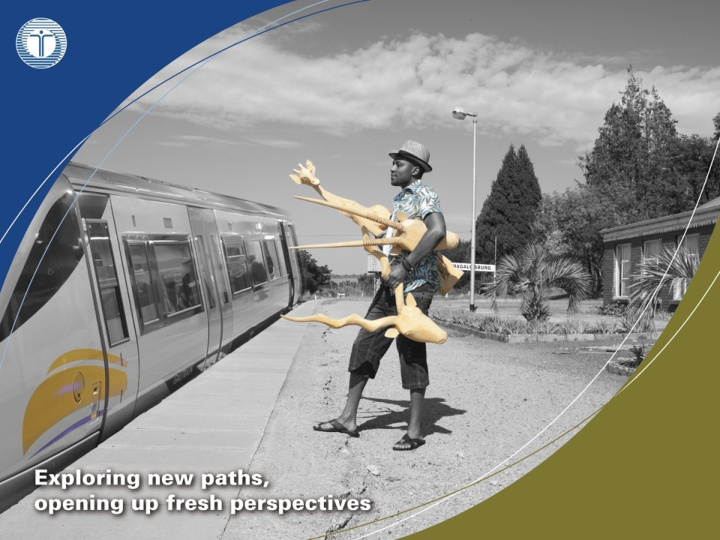



Contribution of Tourism to the Economy of the Limpopo Province HSRC Seminar Series 4 September 2014 Selma Karuaihe Human Science Research Council (HSRC) Economic Performance and Development (EPD)
Background of the Study Objectives Methodology Literature Review Findings Conclusions Recommendations & Policy Implications
Introduction & Background Tourism as a sector contributes significantly to the national and provincial economies of South Africa. However, tourism is not classified as an independent sector as per ISIC Which measures sectors by output Actual contribution of the sector is included in the output and value addition of a number of other sectors in the national accounts, These sectors include: trade services, telecommunications, transportation, accommodation, food and beverage services, travel agencies, recreation and entertainment, among others. The current study aims to establish the sector’s contribution to the Economy of the Limpopo Province through primary survey.
Limpopo Tourism Growth Strategy (TGS 2009 – 2014) The study objectives are guided by the Limpopo TGS, in terms of its focus areas and priorities The main vision of the Provincial Tourism Strategy is to: Make Limpopo Province “the preferred ecotourism destination in Southern Africa” is the tourism vision for the province. The province has identified the following product offerings that are based on six activity clusters: Mega Conservation; Safari and hunting; Golf and Game; Family and recreation; Special Interest (adventure, culture, birding, health, etc.). Meetings, Incentive travel, Conferences & Events (MICE);
Specific Objectives of the Study Determine the contribution of tourism to the targets as outlined in the National Tourism Sector (NTSS) strategy namely: Tourism’s contribution to the provincial and national economy To assess the factors that hinder tourism diversification, new investment and enterprise development in the province To identify the strength, weaknesses, opportunities and threats to the provinces’ tourism industry in a way that prioritizes the focus areas of the national tourism frameworks.
Specific Objectives of the Study continue The Specific Objectives of the research are to: Determine the composition of the current tourism industry in the province, Identify the economic factors and value chain in the six (6) tourism clusters of the provincial tourism growth strategy. Determine the attractions and tourism packages tourists are most interested in when visiting Limpopo; Determine the impact of the provincial domestic tourism marketing strategy; Assess the compliance of the Limpopo tourism industry with BBBEE-EE;
Phase one: Literature review Based on desktop analysis of secondary data These included academic and grey literature and other documents. Phase Two: Survey Used questionnaires to conduct face-to-face interviews with: managers and owners of tourism establishments, tourist attractions and key informants. key informants - mainly experts from government departments dealing with tourism initiatives, district municipalities and the Limpopo Tourism Agencies (LTA) in the respective districts.
Sampling of Accommodation Establishments Categories of Number of Proportion of Number of Accommodation establishment in establishments in establishments Establishments population population per category B&B 52 5% 13 Caravan and Camping 79 7% 20 Cottages and Chalets 42 4% 10 Game Lodge 178 16% 44 Guest Houses 214 20% 53 Hotel 66 6% 16 Lodges 270 25% 67 Self-Catering 192 18% 47 Total Establishments 1093 100% 270
Sampling of Tourist Attractions Tourist attractions Number of Proportion of Number of attractions attractions attractions in population in population in sample Art gallery 12 11% 3 Cultural Village 6 5% 2 Heritage Site 4 4% 1 Museums and 17 15% 5 Monuments Nature Reserve 21 19% 6 Wildlife and Adventure 53 47% 11 Total 113 100% 28
Tourism Number of Responses per Category Category Total Accommodation Establishments 197 Tourism Attractions 24 Key Informants 11 Total number of completed questionnaires 232
Accommodation Sample per District Sampled Percentage of Completed Percentage Establishme Sample per Sampled (%) of Actual nts per District Responses Responses District per District per District CAPRICORN 65 24% 46 23.3% MOPANI 51 19% 34 17.3% SEKHUKHUNE 6 2.2% 11 5.5% WATERBERG 69 25% 46 23.3% VHEMBE 79 29% 60 30.5% Total 270 100 197 100
Attractions Sample per Distri ct Total Number of Percentage (%) of Total Number Percentage (%) Sampled Sample per of Actual of Actual Attractions per District Responses Responses per District Per district District CAPRICORN 3 10.71 5 20.8% MOPANI 7 25 5 20.8% SEKHUKHUNE 0 0 0 0% WATERBERG 11 39.3 9 37.5% VHEMBE 7 25 5 20.8% Total 28 100 24 100
Accommodation and Attractions Per Category: Surveyed Accommodation Percent Type of Attraction Percent Categories Bed and Breakfast (B&B) 28.4% Art galleries 13.6% Caravan and Camping 3.7% Museum & Monuments 9.1% Cottages and Chalets 1.1% Nature Reserve 31.8% Game Lodge 1.1% Wildlife & Adventure 13.6% Guest Houses 25.3% Cultural Village 9.1% Hotel 13.7% Heritage Site 9.1% Lodge 18.9% Other 13.6% Self-Catering 3.7% Other 4.2% Total 100 Total 100
Limitations of the Study The study was conducted during the time of December 2013 to February 2014. During this time, most tourism establishments were busy with bookings for the festive seasons and that limited their participation or availability in the study. In some cases, tourism establishment owners were on holiday away from Limpopo and thus not accessible The study relied on primary data (responses from the survey), which required to be substantiated by secondary data on tourism contributions from other sources: Like Stats SA and Global Insight to support data at the provincial level
THE END THANK YOU
Recommend
More recommend